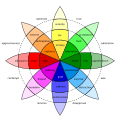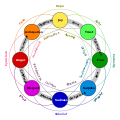Positive mood
Positive mood can be caused by many different aspects of life, as well as have certain effects on people as a whole. Good mood is usually considered a state without an identified cause; people cannot pinpoint exactly why they are in a good mood. People seem to experience a positive mood when they have a clean slate, have had a good night's sleep, and feel no sense of stress in their life.
People tend to be generally in a good mood. [3] There have been many studies done on the effect of positive emotion on the cognitive mind, and there is speculation that positive mood can affect our minds in good or bad ways. Generally, positive mood has been found to enhance creative problem solving and flexible yet careful thinking. [4] Some studies have stated that positive moods let people think creatively, freely, and be more imaginative. Positive mood can also help individuals in situations in which heavy thinking and brainstorming are involved. In one experiment, individuals who were induced with a positive mood enhanced performance on the Remote Associates Task (RAT), a cognitive task that requires creative problem solving. [5] Moreover, the study also suggests that being in a positive mood broadens or expands the breadth of attentional selection such that information that may be useful to the task at hand becomes more accessible for use. Consequently, greater accessibility of relevant information facilitates successful problem solving. Positive mood also facilitates resistance to temptations, especially with regard to unhealthy food choices. [6] Interpersonal relationships have also been shown to have an effect on maintaining a positive mood. Social activities correlate with positive mood as well indicating that social interactions with people may increase an individual's positive mood. [7] Therefore, people that are isolated from society or in the out-group may have a more negative mood than individuals that have a strong social circle. [8]
Positive mood has also been proven to show negative effects on cognition as well. According to the article, "Positive mood is associated with implicit use of distraction". "There is also evidence that individuals in positive moods show disrupted performance, at least when distracting information is present". [9] The article states that other things in their peripheral views can easily distract people who are in good moods; an example of this would be if you were trying to study in the library (considering you are in a positive mood) you see people constantly walking around or making small noises. The study is basically stating that it would be harder for positive moods to focus on the task at hand. In particular, happy people may be more sensitive to the hedonic consequences of message processing than sad people. Thus, positive moods are predicted to lead to decreased processing only when thinking about the message is mood threatening. In comparison, if message processing allows a person to maintain or enhance a pleasant state, then positive moods need not lead to lower levels of message scrutiny than negative moods. [10] It is assumed that initial information regarding the source either confirms or disconfirms mood-congruent expectations. Specifically, a positive mood may lead to more positive expectations concerning source trustworthiness or likability than a negative mood. As a consequence, people in a positive mood should be more surprised when they encounter an untrustworthy or dislikable source rather than a trustworthy or likable source. [10]
Negative mood
Like positive moods, negative moods have important implications for human mental and physical wellbeing. Moods are basic psychological states that can occur as a reaction to an event or can surface for no apparent external cause. Since there is no intentional object that causes the negative mood, it has no specific start and stop date. It can last for hours, days, weeks, or longer. Negative moods can manipulate how individuals interpret and translate the world around them, and can also direct their behavior.
Negative moods can affect an individual's judgment and perception of objects and events. [11] In a study done by Niedenthal and Setterland (1994), research showed that individuals are tuned to perceive things that are congruent with their current mood. Negative moods, mostly low-intense, can control how humans perceive emotion-congruent objects and events. For example, Niedenthal and Setterland used music to induce positive and negative moods. Sad music was used as a stimulus to induce negative moods, and participants labeled other things as negative. This proves that people's current moods tend to affect their judgments and perceptions. These negative moods may lead to problems in social relationships. [11] For example, one maladaptive negative mood regulation is an overactive strategy in which individuals over dramatize their negative feelings in order to provoke support and feedback from others and to guarantee their availability. A second type of maladaptive negative mood regulation is a disabling strategy in which individuals suppress their negative feelings and distance themselves from others in order to avoid frustrations and anxiety caused by others' unavailability.
Negative moods have been connected with depression, anxiety, aggression, poor self-esteem, physiological stress and decrease in sexual arousal. In some individuals, there is evidence that depressed or anxious mood may increase sexual interest or arousal. In general, men were more likely than women to report increased sexual drive during negative mood states. Negative moods are labeled as nonconstructive because they can affect a person's ability to process information, making the person focus solely on the sender of a message, while people in positive moods will pay more attention to both the sender and the context of a message. This can lead to problems in social relationships with others.
Negative moods, such as anxiety, often lead individuals to misinterpret physical symptoms. According to Jerry Suls, a professor at the University of Iowa, people who are depressed and anxious tend to be in rumination. However, although an individual's affective states can influence somatic changes, these individuals are not hypochondriacs. [12]
Although negative moods are generally characterized as bad, not all negative moods are necessarily damaging. The Negative State Relief Model states that human beings have an innate drive to reduce negative moods. People can reduce their negative moods by engaging in any mood-elevating behavior (called Mood repair strategies), such as helping behavior, as it is paired with positive value such as smiles and thank you. Thus negative mood increases helpfulness because helping others can reduce one's own bad feelings. [13]

